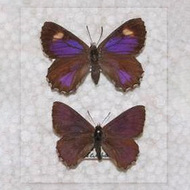Proponents planning searches for the critically endangered Arid Bronze Azure Butterfly should note searches for host ant colonies are recommended prior to any targeted searches for the butterfly.
| Date: | Wednesday, 28 September 2022 |
|---|
Native Vegetation Clearing Permit (NVCP) applications that occur within the potential distribution and habitat requirements of the critically endangered Arid Bronze Azure Butterfly (ABAB) may be required to undertake surveys. Delays to approvals can be minimised by undertaking surveys prior to the submission of any NVCP applications.
The Arid Bronze Azure Butterfly (ABAB) (Ogyris subterrestris petrina) is a medium sized (~36mm) butterfly that is predominately dark grey-brown to black with bronze to purple-bronze colouration on the upper sides of the wings. It is listed as critically endangered under the both the state Biodiversity Conservation Act 2016 and Commonwealth Environment Protection and Biodiversity Protection Act 1999. The ABAB is listed because of its severely fragmented distribution, with only two extant subpopulations being recorded in Western Australia. A recent study ranked the ABAB as the second most likely butterfly from Western Australia to become extinct.
This striking butterfly has a specialised association with a species of nocturnal sugar ant, which has not yet been formally described as a new species. It is currently referred to as Camponotus sp. nr. Terebrans because of its similarity to Camponotus terebrans. ABAB larvae have adapted to emit a chemical that fools sugar ants into thinking the larvae are queen ants. The duped ants escort the larvae to their ant nurseries where the butterfly larvae are either fed by the ants or, more likely, feed on the baby ants. As well as hosting the larvae of the butterfly, the ants also host leafhoppers (Pogonoscopus lenis) within their nests, in another symbiotic relationship.
The adult butterflies are sedentary, making it important to protect existing populations as well as their host ant. The most critical factor for habitat occupancy by the butterfly is the presence of large colonies of the host ant. Only large colonies can support the ABAB, being a parasitic species, it requires large numbers of hosts. Floristically diverse habitats are also needed to sustain high densities of the host ant.
The butterfly’s potential distribution is extensive and encompasses much of the semi-arid zone (rainfall < 325mm), south of approximately 26 degrees latitude, amongst smooth-barked Eucalypts (in particular Eucalyptus salubris, E. salmonophloia, E. capilosa subsp. Wandoo and E. loxophleba subsp. lissophloia). Many flowering plants of the lower, mid and upper storey are likely to be nectar sources for the adult butterfly. In woodlands, many plants such as Eucalyptus, Acacia, Grevillea, Hakea, and annual species would be probable nectar plants. Nectar is likely to peak in availability during September–October, which is also the main butterfly activity (flying) period.
Proponents planning targeted searches for the ABAB should note that searches for host ant colonies are recommended prior to any targeted searches for the butterfly itself and can be conducted year round. An on-ground survey for ABAB may only be needed if the host ant is present in reasonable numbers. A guideline for the survey of the ABAB in Western Australia is available from DBCA. Any survey results will prove incredibly valuable in mapping the presence/absence distribution of this butterfly for future conservation efforts.
Further reading:
- Guideline for the survey of arid bronze azure butterfly (ABAB) in Western Australia
- Arid bronze azure butterfly (ABAB) survey in Western Australia - additional information
- Ogyris subterrestris petrina — Arid Bronze Azure
Contact: DMIRS Native Vegetation Section – 9222 0951


